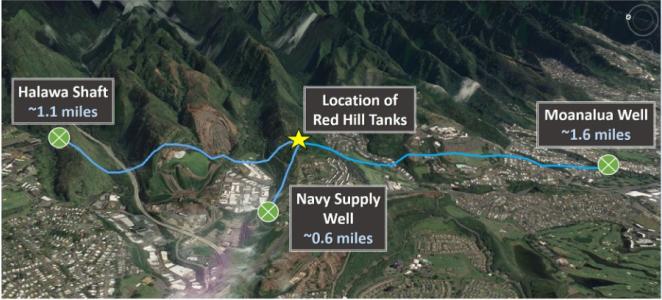 Toward the end of December, the US Navy’s Red Hill Bulk Fuel Storage Facility at Pearl Harbor, Hawaii was drained of fuel, after chronic fuel oil leaks into Oahu’s sole drinking-water aquifer from the World War II era underground tanks. Now that the final tanker has sailed, loaded with the last jet fuel from the vast underground tank farm, the Navy says that Oahu’s water supply is again safe to drink. Local residents, backed by a recent report of an investigation by the Environmental Protection Agency (EPA), disagree.
Toward the end of December, the US Navy’s Red Hill Bulk Fuel Storage Facility at Pearl Harbor, Hawaii was drained of fuel, after chronic fuel oil leaks into Oahu’s sole drinking-water aquifer from the World War II era underground tanks. Now that the final tanker has sailed, loaded with the last jet fuel from the vast underground tank farm, the Navy says that Oahu’s water supply is again safe to drink. Local residents, backed by a recent report of an investigation by the Environmental Protection Agency (EPA), disagree.
The EPA findings have sparked inquiries into the Navy’s water distribution center and plumbing in Pearl Harbor Homes. While the Navy examines residents’ plumbing, a citizens group is urging the Navy to take further safety measures.
According to its investigation, the water in three of four homes detected petroleum hydrocarbons as diesel, ranging from 56 to 71.2 parts per billion. The EPA noted that all petroleum hydrocarbon results were below the Hawaii Department of Health’s screening level of 266 parts per billion for total petroleum hydrocarbons.
Activists, including Wayne Tanaka of the Sierra Club, are expressing concerns about the water testing methodology and standards. Despite petroleum levels being below the Hawaii Department of Health’s screening threshold, concerns persist that the levels may not accurately reflect the threat posed.
Among their complaints: residents observed a strange order or oily sheen in the water and developed symptoms similar to those observed during the 2021 contamination. Residents reported that they or their children had developed unusual rashes, headaches, heartburn or fatigue after drinking the water.
The Red Hill Facility of 20 underground steel fuel tanks encased in concrete, each about 20 stories tall, were carved into the basalt rock after the Japanese attack on Pearl Harbor in 1941, in response to concerns that above-ground fuel depots would be targets for subsequent strikes.
The problems at Red Hill have long threatened more than the Navy water supply, given the aquifer’s role in serving the island of Oahu. The 76 spills since World War II resulted in leaks of nearly 200,000 gallons of fuel, which experts say is probably an undercount.
In March 2022, the Pentagon announced plans to permanently shut down Red Hill.
In a statement, Navy Rear Adm. Stephen Barnett agreed to conduct further testing, share the results with regulators, and continue testing in March 2024 and beyond.
